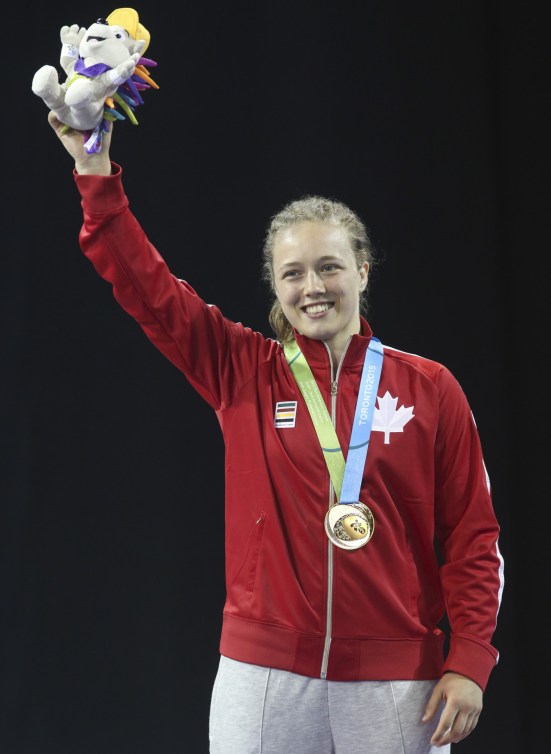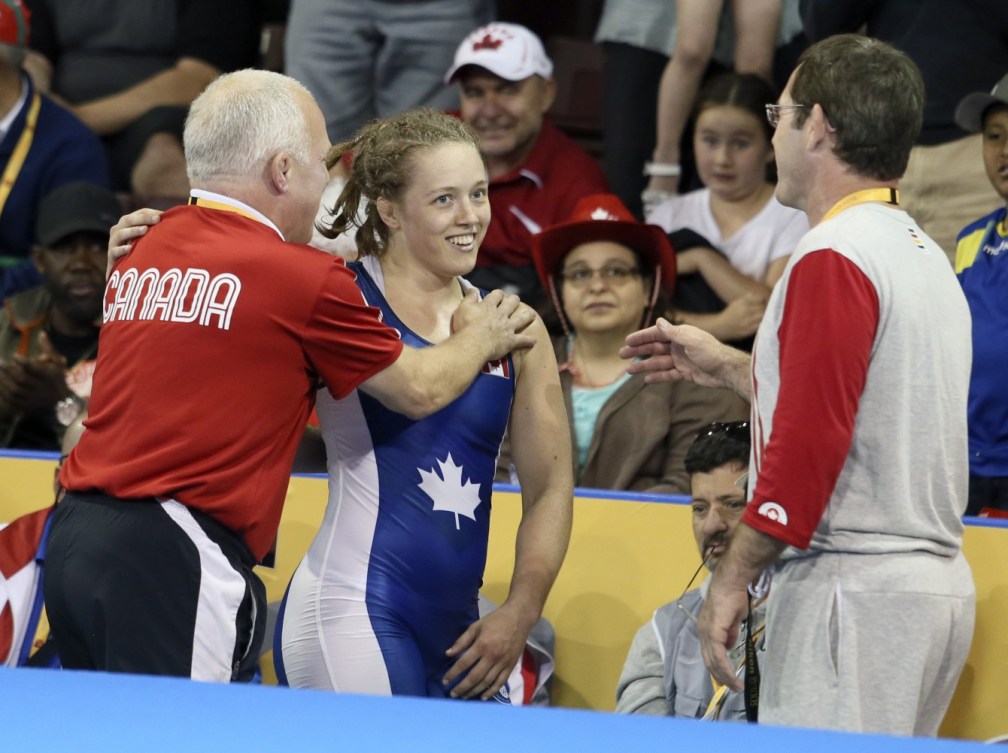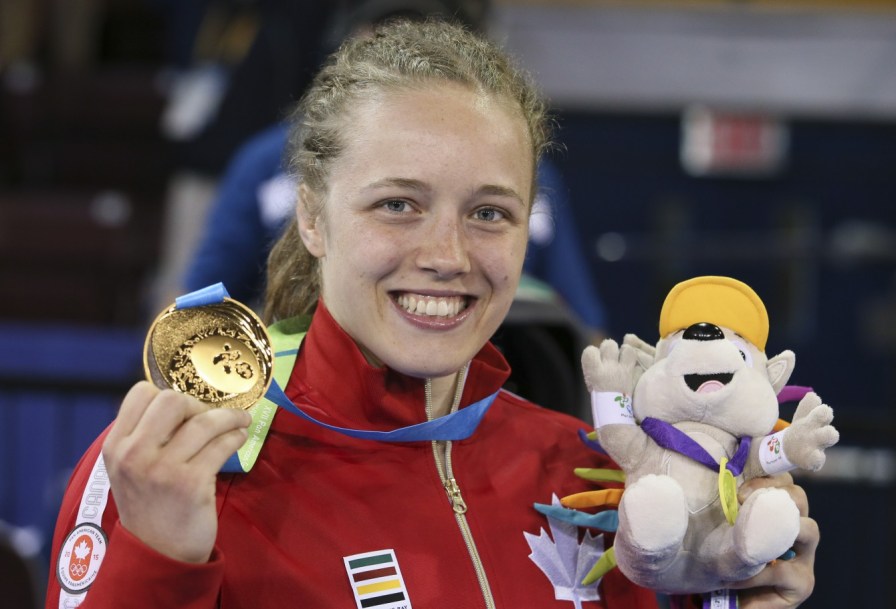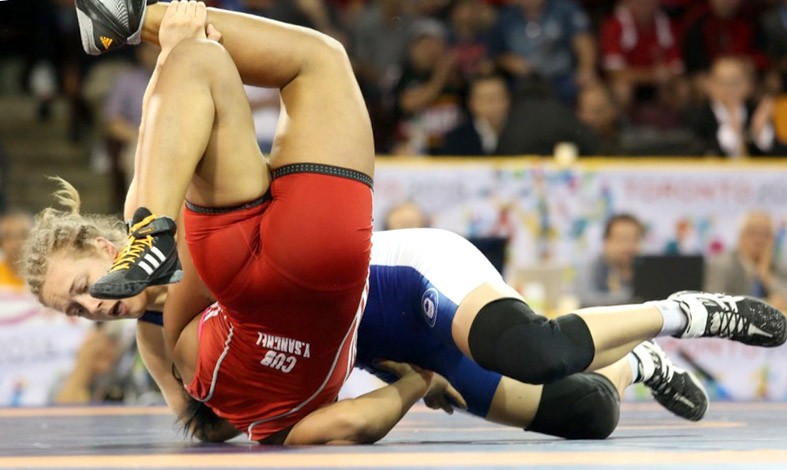Help Build an Olympian: Dori Yeats wrestles her way to Pan Am gold
Day 7 was a four medal day for Canada on the mat in Mississauga. Dorothy (Dori) Yeats won gold in the women’s 69kg category, handily defeating her Venezuelan opponent 13-2. She matches the accomplishment of her father Doug, who won Pan Am wrestling gold in 1979.
The days and weeks leading up the competition can be a stressful time for wrestlers as they manage their diet to make it into their weight class.
Dori manages the stress by working with a sport and performance nutritionist, Alexia de Macar, who has worked with high performance athletes for over ten years. “My role is to support Dori by educating her on what her body needs when and in which amounts for each of her training phases and competition periods,” says Alexia.
By working with Alexia, Dori can now track her weight much better: “I was always light for my weight class. I used to be at least 2kg under the weight class that I was competing in and never had to really watch what I ate or when I ate.“ Alexia’s advice is invaluable to Dori. She provides her with a weekly program of what to eat, when to eat and how much to eat. Using a body scan machine, she tracks Dori’s body composition and weight. Alexia also uses a refractometer – a hand-held device that measures hydration – to measure Dori’s daily hydration levels in order to track her water intake.
Fighting fit
Dori works with a whole team of coaches and sport science experts such as Alexia. These experts form Dori’s Integrated Support Team – IST – who all work together to ensure that Dori has access to the best training, research and support. Luckily, she can also count on her dad who is both a five-time Olympic Greco-Roman wrestler and Dori’s manager.
Dori and the team work through the different phases of preparing for major competitions like the Pan Am Games. Focusing on her weight and nutrition is relatively new for Dori who says, “In the last two years, I have worked a lot on gaining muscle and putting on weight to be the same size as my opponents. I only started paying attention to my weight when I was 20 (I am 21 now).”
As a long-time sport nutritionist, Alexia understands how to adapt to an athletes unique needs.

Dorothy Yeats (blue) of Montreal celebrates her gold medal in the freestyle wrestling finals at the PanAmerican Games in Mississauga, Ont., Friday, July 17, 2015. Photo by Mike Ridewood/COC
“Dori has different nutrition plans to follow: one for the training period (that will vary according to her strength and conditioning goals) and one for decreasing weight. Ideally, we don’t want to lose more than 1% of body weight per week so we might start making nutritional changes 3-4 weeks before the competition depending on her weight.”
The weigh-in
For wrestlers like Dori, the first part of the competition begins at the weigh-in. Here, athletes are weighed to make sure that they meet the standards of their weight class. For some, the dietary restrictions can cause large fluctuations in weight. As Dori says, “For wrestlers who cut more weight than I do, there is more of a fluctuation because they tend to crave certain foods more after they have restricted themselves trying to make weight.”
While training, however, Dori usually stays within five percent of her competition weight. While this makes it easier for her to make weight, it still requires her to carefully manage her daily meals. “The weigh-in is the night before the competitions,” she explains, “I have to change my eating habits a few weeks before the weigh-in and I have to reduce my water intake one day or two before the weigh-in, to make weight.”
For Dori, everything she eats and drinks affects how she competes. Wrestlers have to be at or below the weight class in which they compete. “My weight class is 152 pounds or 69kg so I have to be exactly 69.0 kg in order to “make weight.” If I am 69.1 or even 69.01 kg, I cannot compete,” explains Dori.

Dorothy Yeat (blue) of Montreal celebrates her gold medal with her coaches in the freestyle wrestling finals at the PanAmerican Games in Mississauga, Ont., Friday, July 17, 2015. Photo by Mike Ridewood/COC
In the cutting weight phase, Alexia lays out a plan to decrease Dori’s weight in a healthy way. Dori will still eats three meals a day; Now, however, her meals have fewer added fats and sugars. She will eat exactly the serving sizes she needs and nothing extra. After training, snacks will help her body’s ability to recover. The week before the weigh-in, Alexia will decrease Dori’s carb intake as well as limit how much sodium, high-fibre foods and fat she can digest. Finally, they will carefully limit the water Dori drinks.
Weighed and measured
Still, it’s not all over after Dori has made it into her weight class. The competition is the following day and there is still a lot to be done to make sure her performance is optimal.
“After the weigh-in, I follow a specific recovery plan to replenish my carbohydrate stores and rehydrate. This isn’t a time to eat whatever I want; I have to eat the best foods to make me prepared to compete the next day. Since weigh-ins are in the afternoon-evening, I do not work out after a weigh-in. I just focus on my nutrition.”
Alexia stresses the importance of nutrition in this pre-competition period: “Re-feeding and re-hydrating properly is extremely important if you want to maximize your performance the next day.”
For Dori and her team, nutrition is part of a well-rounded strategy that continues to pay off.

 Canadian Olympic Foundation
Canadian Olympic Foundation



